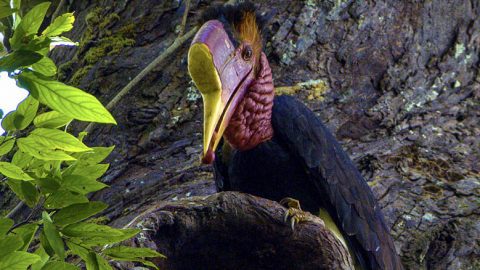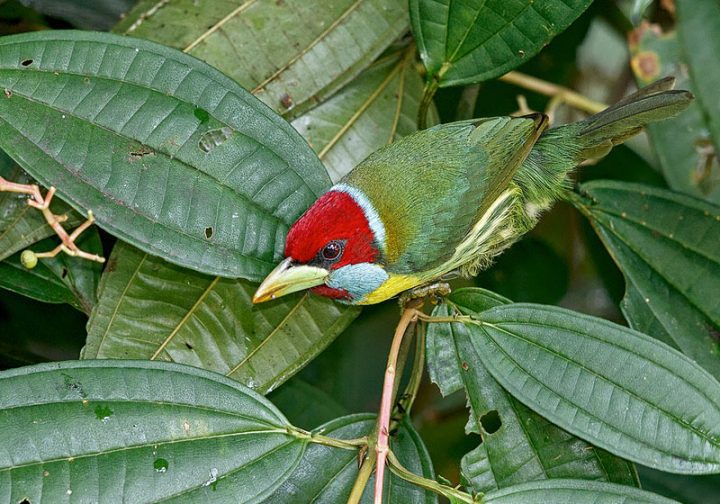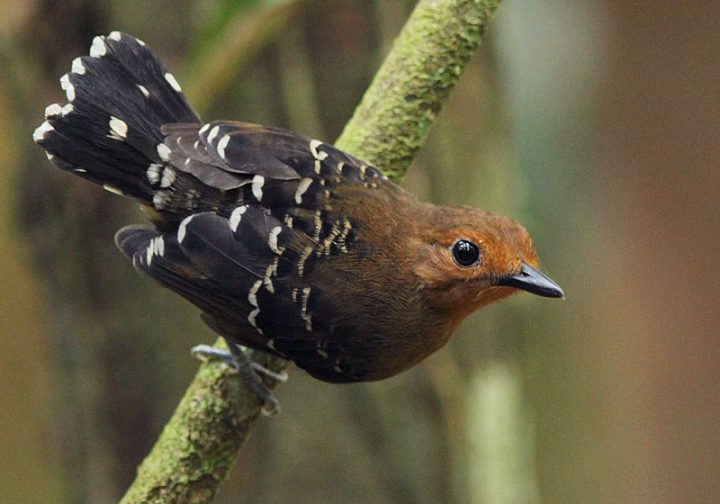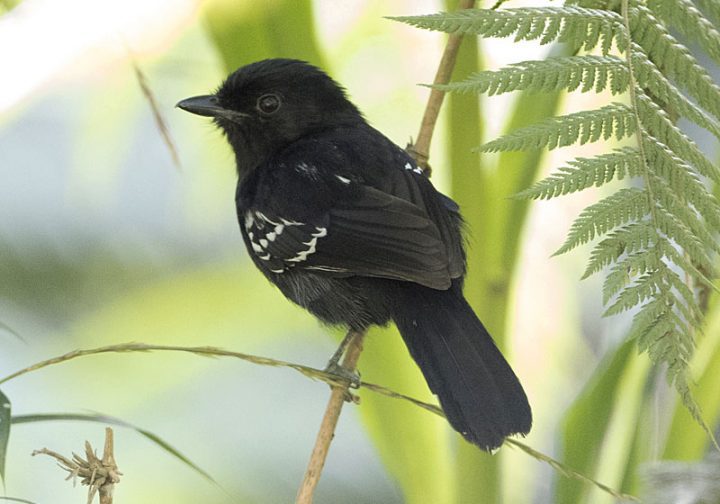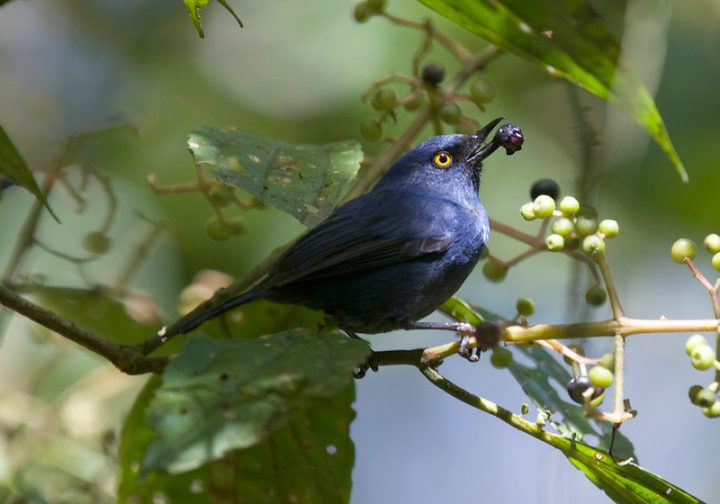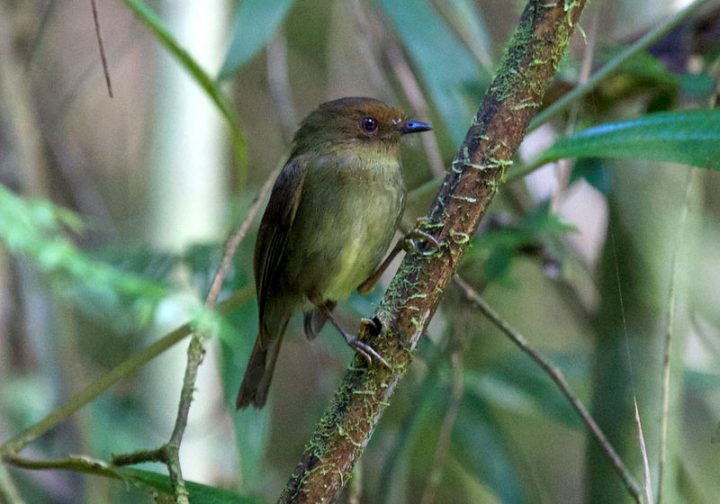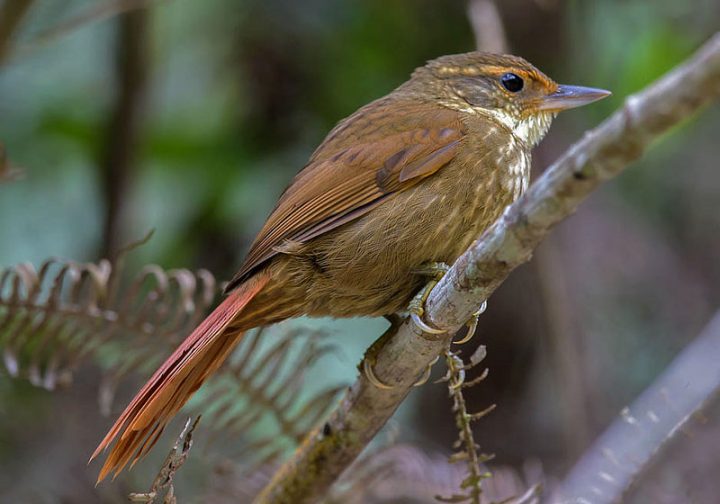Escalator to Extinction Carries Species Off the Top of a Mountain
By Marc Devokaitis
Versicolored Barbet by Roger Ahlman/Macaulay Library. December 20, 2018From the Winter 2019 issue of Living Bird magazine. Subscribe now.
A basic rule of the Earth’s climate—familiar to any kindergartner who’s drawn snow-capped mountains on construction paper—is that the air gets cooler at higher elevations. This quirk of physics gives animals that live on mountains some temporary respite from climate change: as the world warms, they can move upslope to find temperatures they’re accustomed and adapted to. But mountains don’t go up forever. So what happens to animals that are already living at the top?
This question was recently put to the test on a mountain range in the foothills of the Peruvian Andes. Using a nearly forgotten set of survey data from 1985 and recreating that study’s methods, scientists found that the birds there now live higher upslope, occupy less area, and have smaller local populations than they did three decades ago. And fully half of the species that lived only at the highest elevations seem to have disappeared completely.
In the 1985 survey, a team of researchers from Chicago’s Field Museum including John Fitzpatrick (now director of the Cornell Lab of Ornithology) spent six months in the Cerro de Pantiacolla, a small mountain ridge in Peru. They documented the rich tapestry of bird life along a path that rose more than 1,000 meters (more than 3,000 feet) from a river to the top of the ridge. In all they recorded range information for 450 bird species, from ubiquitous Olive-striped Flycatchers to the rare, ridgetop-dwelling Deep-blue Flowerpiercer.
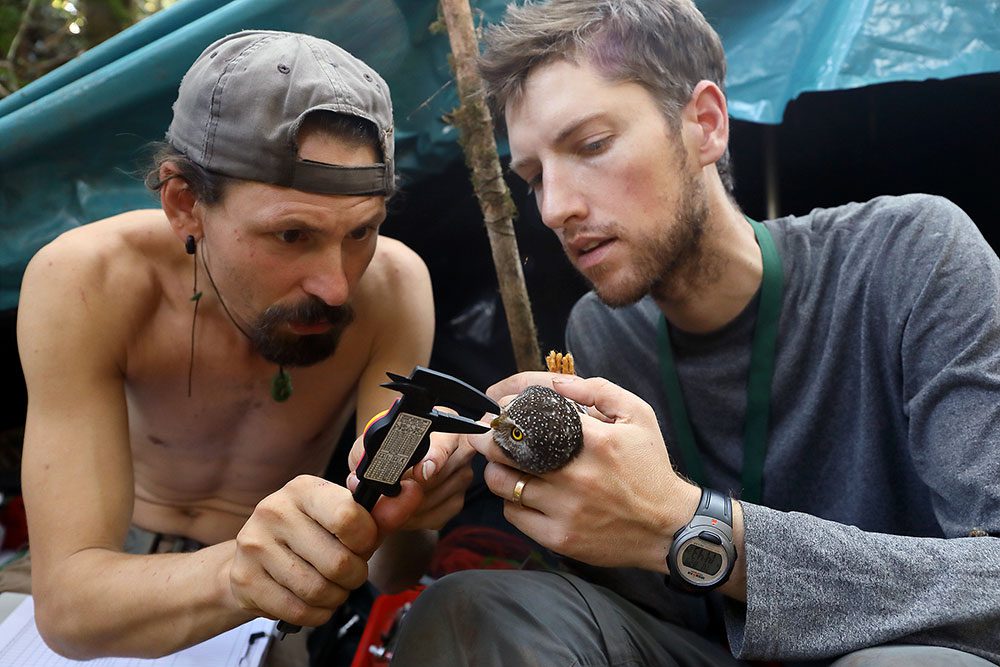
Those data were never published, but in 2014 Fitzpatrick found himself discussing the Pantiacolla survey with Cornell University graduate student Ben Freeman. Freeman had just published research showing that mountain birds in Papua New Guinea were shifting their ranges upslope in response to warming temperatures. Those findings relied on comparing a contemporary bird survey with data from 50 years earlier, which Freeman accomplished by retracing the footsteps of an expedition by Jared Diamond in the 1960s.
As Freeman and Fitzpatrick talked, they realized the old Pantiacolla notebooks could serve as the baseline data to look for range shifts among tropical mountain birds in Peru.
“Frankly, my initial feeling was…it’s hard for me to imagine there would have been a big shift in just 30 years,” recalled Fitzpatrick.
Nevertheless, in 2016 Fitzpatrick returned to Peru with Freeman—now a postdoctoral fellow at the University of British Columbia—to scout out the feasibility of a resurvey. Not a trace of the original base camp or transects remained.
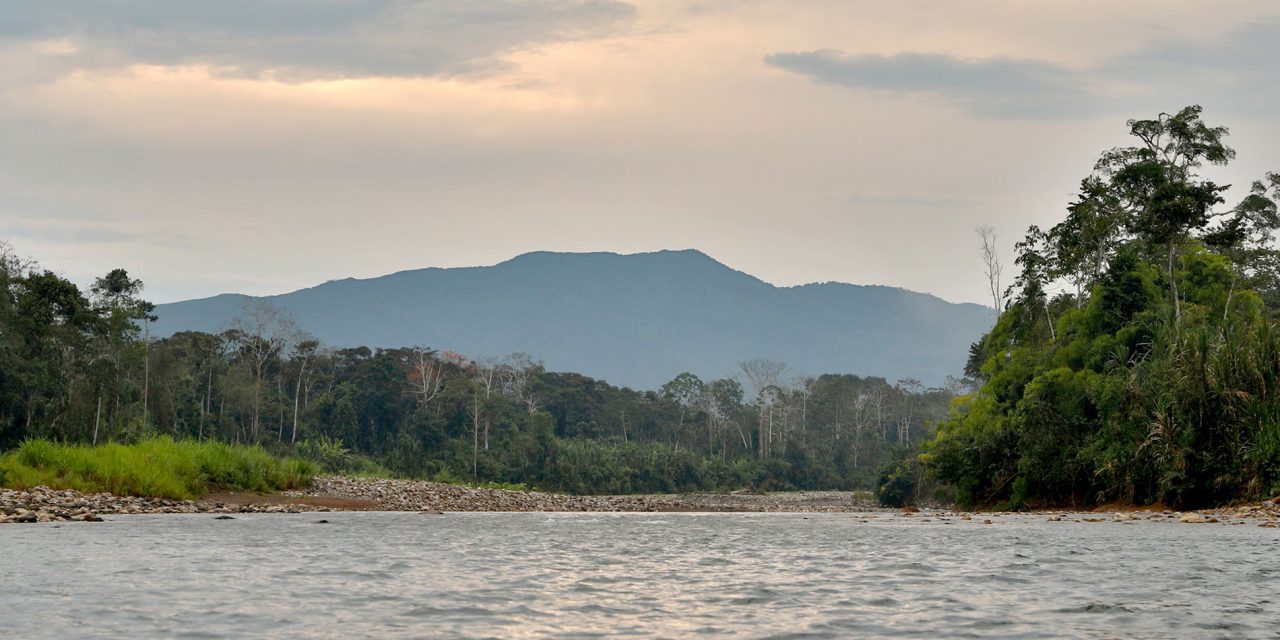
“The original study was in the pre-GPS days,” says Freeman. But by using Fitzpatrick’s personal recollections, modern satellite images, and old topographic maps, the duo relocated the old 1985 base camp. Then they recruited the help of members of the local Matsigenka tribe to clear the long-overgrown route to the highest spot on the ridgeline.
“Happily, the mountain ridge is still in pristine condition,” said Fitzpatrick. Most of the mountains and lowlands in the area, including Pantiacolla, are part of a system of reserves centered around what is now Manú National Park, known as one of the most biodiverse areas in the world.
Freeman returned the next year with a team of biologists to resurvey the newly remarked route. The researchers also set out Swift audio recording units from the Cornell Lab’s Bioacoustics Research Program to capture bird sounds around the clock. The audio recordings augmented the surveys of birds seen by the scientists.
When he compiled all the data, Freeman found something similar to what he had documented in New Guinea–mountaintop species are retreating upslope and running out of mountain, even after just 30 years. Bird species now live an average of 40 vertical meters (130 feet) higher up the mountain than they did in 1985. The upward shifts in ranges showed up across all types of birds—fruit eaters and insect eaters, ground foragers and canopy feeders, larger birds and smaller birds.
In this part of Peru, average annual temperature has risen 0.42 degrees Celsius since 1985. According to Freeman, “the only factor that explains the consistent shifts we see is changing temperatures.”
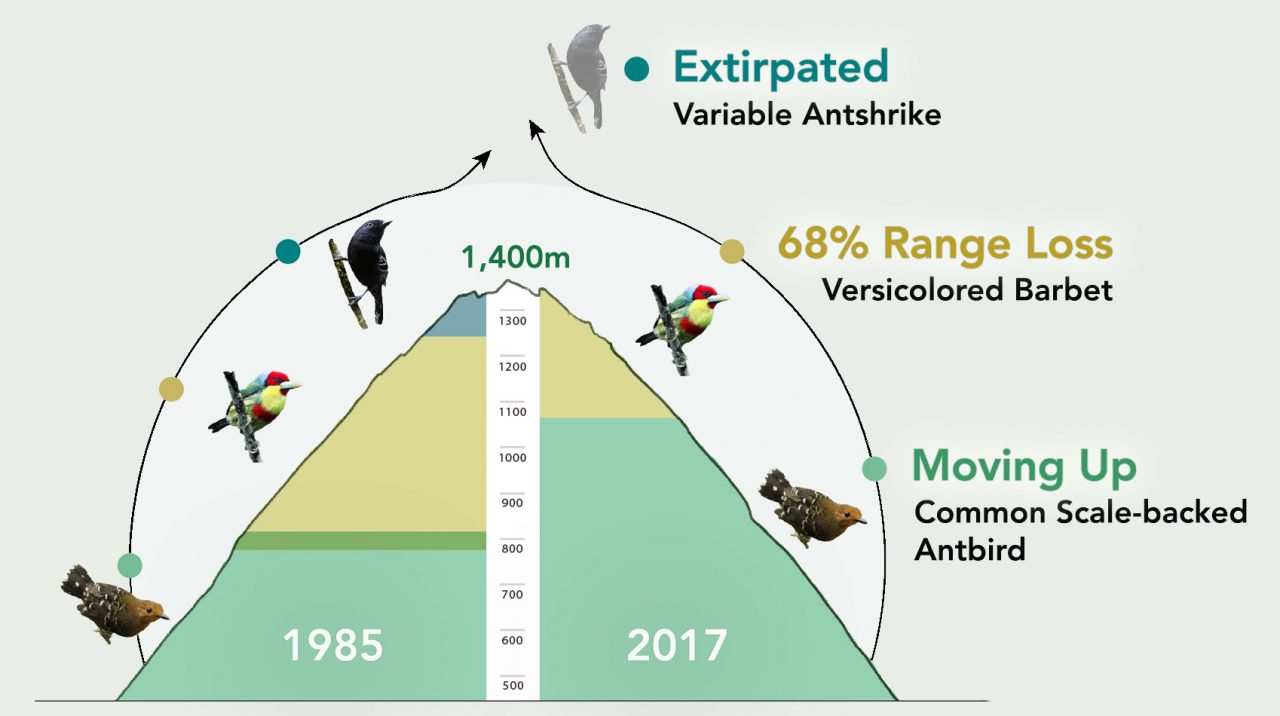
At the very top of the mountain, Freeman’s team found that eight out of 16 “ridgetop specialists” had disappeared, including the Variable Antshrike, Buff-browed Foliage-gleaner, Hazel-fronted Pygmy-Tyrant, and Fulvous-breasted Flatbill. Back in 1985, Fitzpatrick had noted that all of these birds were fairly common.
Because mountains are usually pyramid-shaped, moving uphill tends to decrease the total area available for the species to inhabit, especially at upper elevations. Some birds along Pantiacolla lost two-thirds of their range area as they shifted upslope. Nearly all the species living above 1,200 meters (almost 4,000 feet) had declined in abundance since 1985. In other words, the high-elevation mountain birds of the Pantiacolla had less space to live in, and there were fewer of them.

The Versicolored Barbet's range has shrunk by two-thirds in the last 30 years. Photo by Bryan Hix via Birdshare. 
The Common Scale-backed Antbird is a low-elevation bird expanding its range up the mountain. Photo by David Beadle/Macaulay Library. 
Variable Antshrike was not detected on the mountain by Freeman in 2017. It had been fairly common during Fitzpatrick's 1985 survey. Photo by Brian Sullivan/Macaulay Library. 
The Deep-blue Flowerpiercer is a ridgetop dweller. Photo by Robert Tizard/Macaulay Library. 
The Hazel-fronted Pygmy-Tyrant is a ridgetop specialist and was common in 1985. It is no longer on the mountain. Photo by Robert Tizard/Macaulay Library. 
The Buff-browed Foliage-gleaner is another ridgetop specialist that has disappeared from the mountain since 1985. Photo by Jean-Luc Baron via Birdshare.
Fortunately, the species that vanished from the top of Cerro de Pantiacolla are still fairly common in other parts of South America. But like an experiment conducted in a test tube, Freeman’s research on this small mountain in Peru illustrates a broader reality. And it echoes his previous research on the other side of the world that showed 70 percent of bird species on New Guinean mountains were moving upslope. As global temperatures keep rising, mountain species all across the tropics will have to keep moving steadily upward, as if on an escalator, to stay within their climate zone.
“This is the first fieldwork evidence to show that some local bird populations were literally wiped out by upslope shifting,” said Fitzpatrick. “We think this pattern is probably being repeated on tropical mountain slopes all over the world.”
Freeman says that with Earth’s average temperatures predicted to warm at least 3 degrees Celsius by 2100, tropical species can be expected to shift upslope by another 500 meters (or 1,600 feet) by the end of this century.
Such continued upslope range shifts “would lead to over 60 species disappearing from the Cerro de Pantiacolla,” says Freeman, “and would result in the global extinction of dozens of splendid birds…that live only near the top of mountains in this region.”
References
B.G. Freeman, M.N. Scholer, V. Ruiz-Gutierrez, J.W. Fitzpatrick. 2018. Climate change causes upslope shifts and mountaintop extirpations in a tropical bird community. Proceedings of the National Academy of Sciences 115(47):11982–11987. https://doi.org/10.1073/pnas.1804224115.
B.G. Freeman, A.M. Class Freeman. 2014. Rapid upslope shifts in New Guinean birds illustrate strong distributional response of tropical montane species to global warming. Proceedings of the National Academy of Sciences 111(12):4490–4494. https://doi.org/10.1073/pnas.1318190111.

All About Birds
is a free resource
Available for everyone,
funded by donors like you
American Kestrel by Blair Dudeck / Macaulay Library
